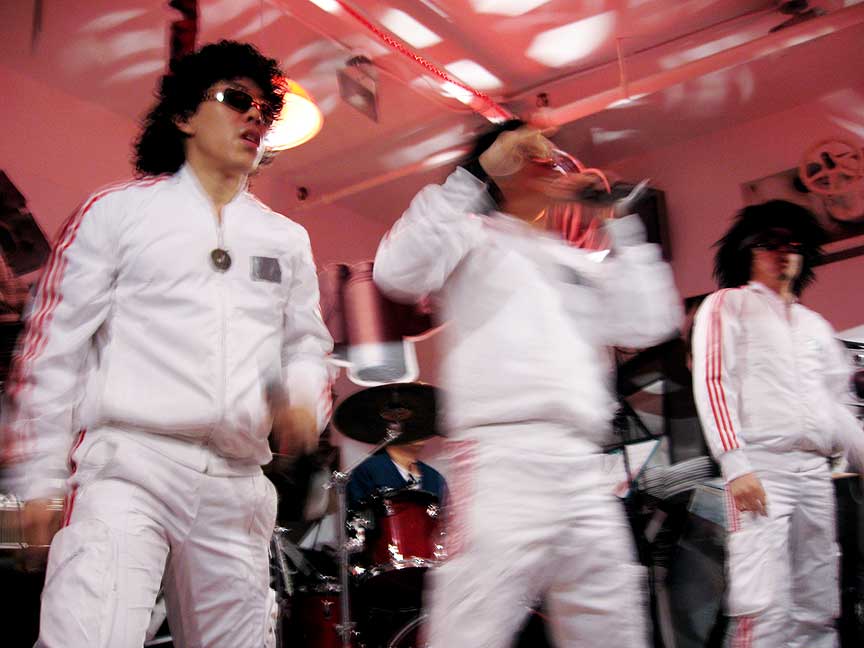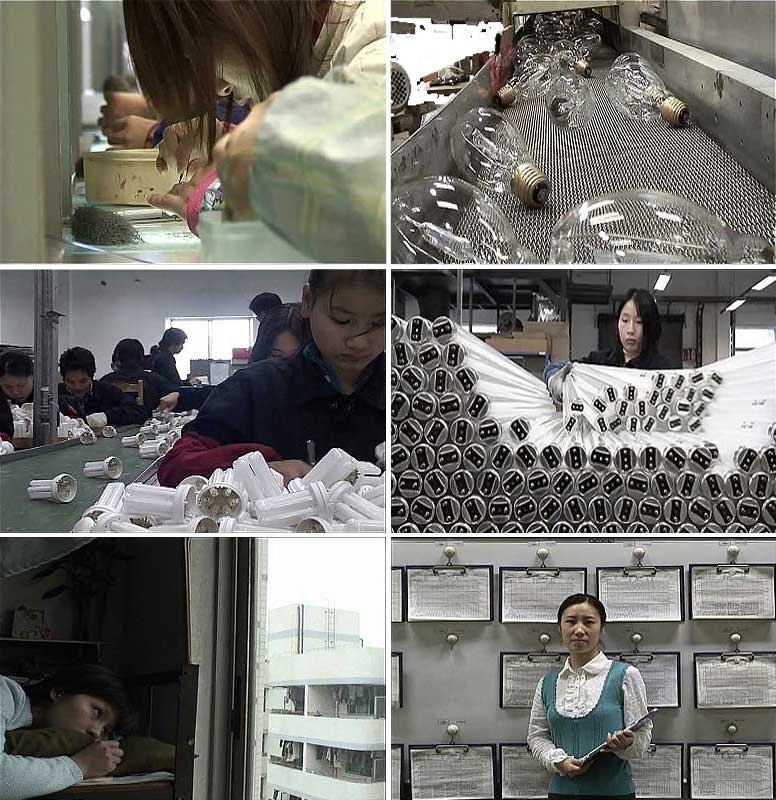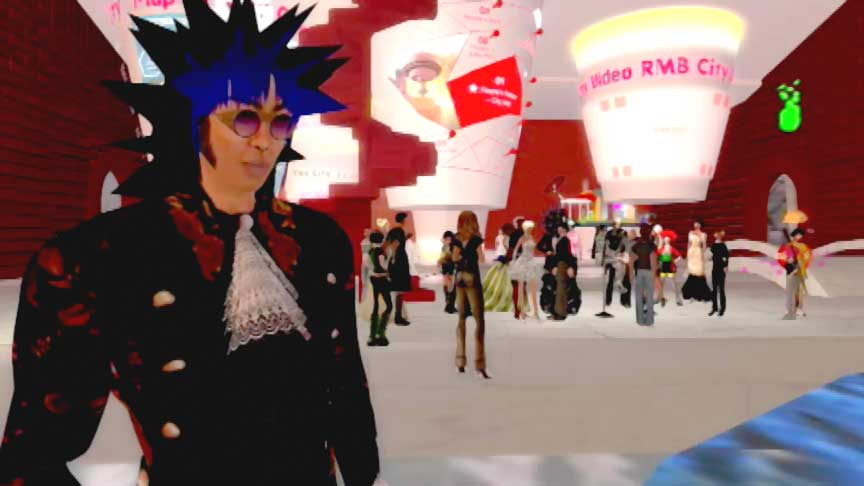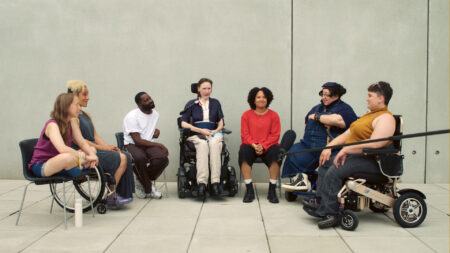Interview
Coming Up Hip-Hop and Questioning Utopia

Cao Fei, Hip Hop Performance, 2006. Production still; 30 minute video. The Notorious MSG opening night performance at Lombard-Freid Projects, NY. Courtesy the artist and Lombard-Freid Projects, New York. © Cao Fei.
In this interview Cao Fei discusses cultural hybridity and her Hip Hop series, and the factory workers featured in her multi-part project Whose Utopia.
ART21: Let’s talk about hip-hop. It’s about suburban survival or a state of survival or state of living. Did you feel that you could implant hip-hop culture, which is basically a black American cultural form that started at the bottom and was later given cultural status, to a totally alien culture, Asian culture? Were you thinking about issues of cultural mobility or something else?
CAO: It goes without saying that our generation has grown up in a fluid and mobile environment where cultures mix and diverge. For example, when I was little I would go out and learn street dance. Later I fell in love with hip-hop music. But I am still a girl who grew up in Guangzhou. Cultural hybridity is deeply rooted in my upbringing and it is reflected in my early theatrical works, including Rabid Dogs (2002). In fact, all my work reflects a diverse assortment of cultural layers. Life itself for my generation is a dynamic and evolving process, and one does not need to organize or sort everything out in an orderly way. So when it comes to shooting hip-hop scenes, I tend to do it naturally. And, when you want to express this kind of hybrid complexity, you rely on the use of interactive plays and applications, appropriation, juxtaposition, and assemblage. It’s like the notion of sampling in hip-hop, mixing all kinds of things together. Life itself is a blur; existence is chaotic.
ART21: You have collaborated with musicians in many of your works, including your “Second Life” project and Hip Hop Performance (2006) at Lombard-Freid Projects in New York City. How do you feel about collaborating with musicians?
CAO: I think my relationship with music probably started with the influx of MTV and its accompanying culture. It was around the late 1980s and early ‘90s when China was first exposed to foreign pop culture. In my teenage years I watched lots of foreign music videos. In music videos, “visuality,” montage, music, and image are all blended together into a single process. The influence this left on me was that music and text can certainly enjoy a very close relationship. If I had grown up just reading—focusing on the written word—or of I had been into photography or still images—I would probably be a very different person than I am now. My way of thinking would have been totally different. But the idea of sound and image working together naturally affected the way I choose to express myself. Perhaps music takes the place of something narrative and feeling, or even replaces the role of narration. This is why in my hip-hop projects, or even in the factory scenes of Whose Utopia (2006), or in Second Life, music becomes a very emotional part of the work.

Cao Fei. Whose Utopia, 2006. Production still, high definition single-channel color video with sound, 20 minutes. Courtesy of the artist and Lombard-Freid Projects, New York. © Cao Fei.
ART21: Tell me about the challenge of transplanting your performances and exhibitions into different localities.
CAO: Guangzhou was the first stop for my Hip Hop project. After, I was invited to present it in other cities and I wanted to see if this form of communication could have a dramatic effect in foreign countries. New York City is already pretty hip-hop, so I picked The Notorious MSG to perform at my opening in New York.
After my first Hip Hop project I started working on COSplayers (2004). Neither cosplay nor hip-hop is native to China; neither one originated here. But when we experience cosplay, or when we use it, you feel that it has become indigenous and original. We translate cosplay into Chinese as “role playing.” It comes from a generation of young people influenced by cartoon culture within the framework of Asian culture as a whole. Individuals come to be known for their imitation of one or another cartoon character. Even in real life they put themselves into the cartoon characters’ roles, giving up their real identity to act out the characters, so much so that they let the characters replace themselves in their everyday lives and routines. It’s a new kind of role reversal, which reflects the younger generation’s discontent with their actual roles in real life. The fact that they choose these fictional characters indicates their disillusionment and the gap between the generations. Each has its own world and its own assumptions.
ART21: Whose Utopia (2006) is a very unique work because it first started as a Siemens Corporation commission and then outgrew the range of the original project. You expanded it, first with video, then with study and research. There are many different aspects. It finally ended up becoming a complete system that included its own newspapers. Tell me more about this project.
CAO: In Whose Utopia, there is an avatar-like element, with factory workers role-playing their fantasies. The theme of reality versus dream and fantasy is present throughout my works. And I think that settings or surrounding backgrounds have a profound influence on characters and how they relate to each other. So when I first got the invitation from Siemens Corporation to create a work my first thought was that this might be a good opportunity to shoot inside a factory. But it was very difficult to shoot due to the high levels of security and difficulty getting inside. At the time the topic of the Pearl River Delta as the factory of the world was still out there. I felt I had to get a firm grasp of the whole picture, to go behind the scenes in the factory and discover something about the essence and soul of the place, before plunging into the creative process. Every artist has a different approach to working on a project. What I had in mind was to discover some of the inherent problems. When the work finally came out, some Western viewers reacted by saying how much they hate the idea of the world’s factory, the exploitation of multinational capital, and the poor treatment of workers it so often entails. But I don’t think Whose Utopia is about this. It’s not an exposé, nor is it about political correctness. Rather, it attempts to look at and examine a particular kind of reality from multiple angles—how workers are on the lookout for the opportunity to survive; where they are now versus the kinds of dreams they have; their experiences growing up; their nostalgia or memory of their hometowns, their traditional Chinese families, their life experiences living inland, and how they migrated into urban life; and their hopes and aspirations for the future. These are the main issues. Before Whose Utopia I almost never worked on commissions. Now, I think of my commissioned projects as experiments.

Cao Fei. Whose Utopia, 2006. Production stills, high definition single-channel color video with sound, 20 minutes. Courtesy of the artist and Lombard-Freid Projects, New York. © Cao Fei.
ART21: Can you talk about your process for working with Siemens employees?
CAO: We first conceived of a series of questions and did a preliminary study of the assembly lines. Then, we picked some workers based on the results of the questionnaire, choosing those who provided interesting answers on the questionnaire. They all came from different assembly lines. They collaborated with us in group workshops.
ART21: Whose Utopia touches on issues of power and artists’ positions and relationships with their collaborators. It’s about the balance of speaking on someone’s behalf without interfering with one’s creative process. In what way do you hold yourself responsible for the feelings and emotions of your subjects?
CAO: I look at it this way: When corporations invite artists to collaborate the project is a cultural endeavor on the part of the corporation. However, what artists do in the art world is not all that important to corporations. What is important is that our commissioned projects enhance the cultural life of the corporation. How do you negotiate your relationship with your subjects in this kind of situation? When I engaged Siemens employees in face-to-face conversation, I didn’t feel much of the corporate presence. We went out to eat together, and they invited me to karaoke parties. I used to believe that corporate employees were a disadvantaged, underprivileged group, but I have abandoned this idea. I got to know them and came to understand and appreciate their hopes and dreams. They have a clear understanding of themselves, their status and identity, and where they stand in society. I realized that there is no “power issue” at play.

Production still from the Art in the Twenty-First Century Season 5 episode, Fantasy. © Art21, Inc. 2009.
ART21: All your works share one common trait—they are about how an individual faces or confronts the larger society, a formidable system, be it a global market society or the establishment of a nation-state, and what forms we adopt in order to participate in society.
CAO: In many works I try to find different ways to connect and interact with society. At the same time, I am trying to construct a new model of society, such as in works like RMB City (2008), which was conceived when I was still exploring in Second Life. I had already developed an understanding of how Second Life works, and I was wondering if I could have my own country, my own community, and my own city built purely by myself. So I started to envision what this city might look like. The video for RMB City is essentially and imagining, a draft design of its overall appearance. RMB City represents any contemporary city in China. But it is also an imitation, to mirror the building and development of an urban center in a theatrical manner. I don’t think its appearance is even the most important issue. Its design could be much wilder and crazier. It’s not a total utopia. It’s a utopia in the making. RMB is the abbreviation for the Chinese currency, the renminbi. Renmin means “the people.” And the R could almost stand for republic or revolution. In Chinese, the name sounds like “the people’s city.” So it comes to take on all these associative meanings. I think it also sounds like “remember city,” a city of memories, because it is actually documenting what cities look like today.
The interview was conducted in December 2008 at the artist’s studio in Beijing, China by Philip Tinari. The interview was translated by Xiaotong Wang and originally published on Art21.org in December 2013.



